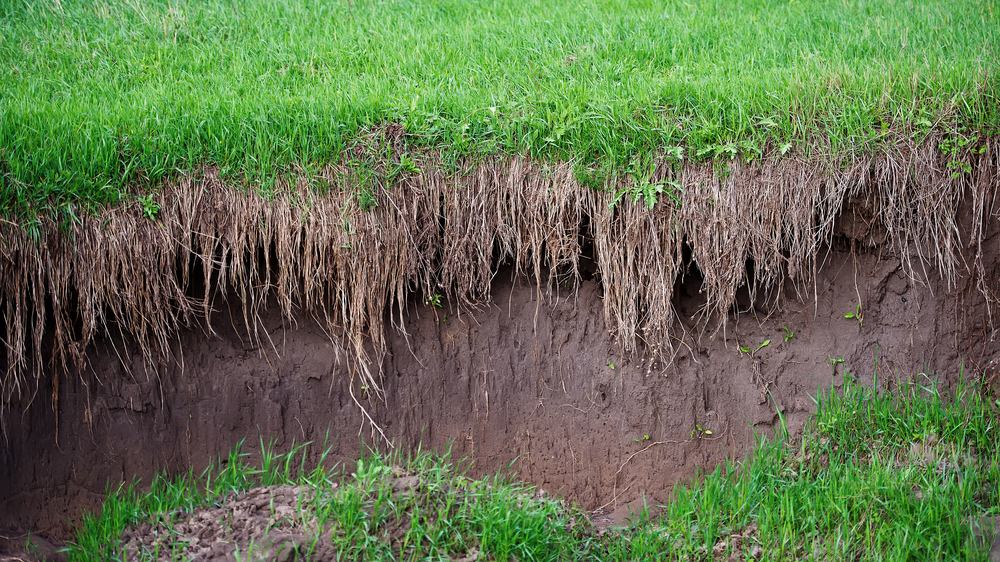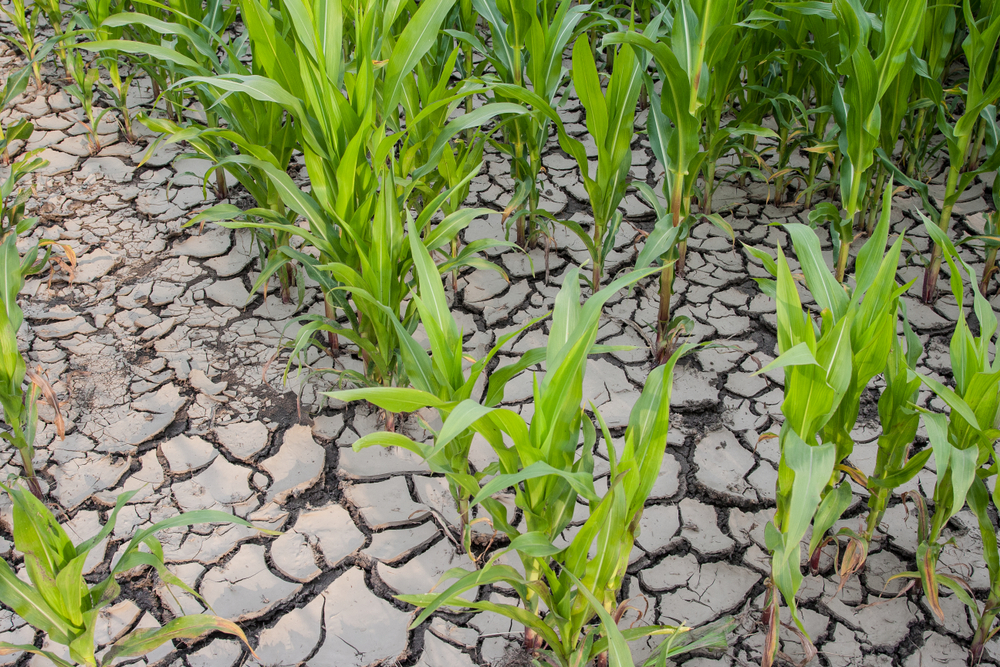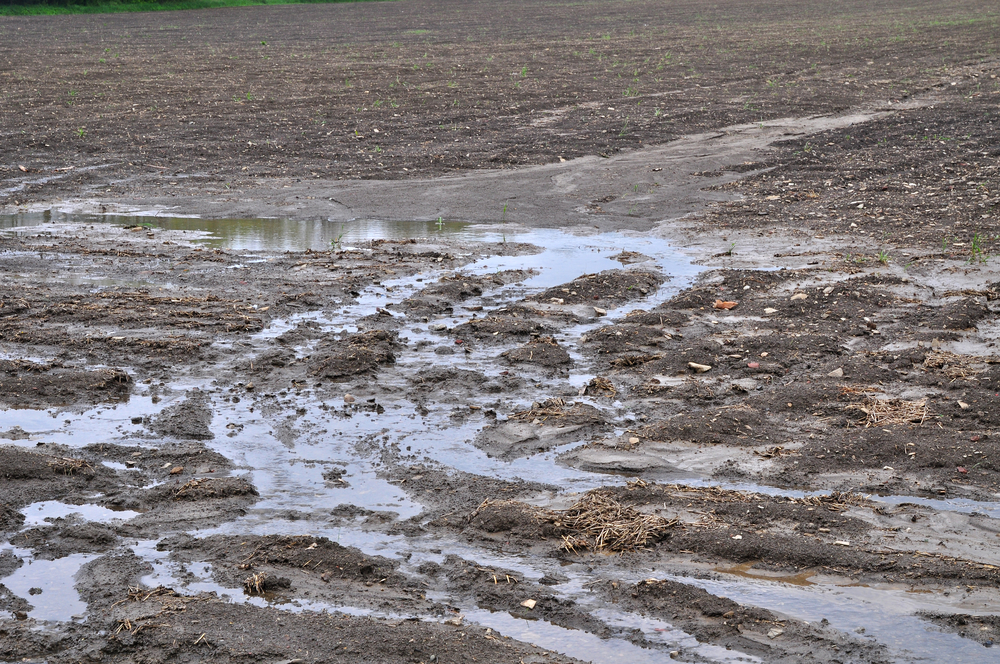Soil Erosion and Rainwater Runoff Harm the Chesapeake Bay
SOIL EROSION

Spot Erosion Problems
Gullies are an example of soil erosion in its most destructive form. But not all erosion problems are easy to spot. It takes a trained eye. Start by noting the way water flows in and around your lawn or garden. Does rainwater rush uselessly down driveways and walkways and into nearby storm drains? Or, does it penetrate slowly into the soil to nourish thirsty plants? Knowing where the water goes is the first step in tackling erosion problems. Here are some other important clues that may indicate soil erosion problems on your property.
SOIL EROSION

- A Muddy or cloudy water in the driveway, road, or gutter following rain or watering.
- Newly exposed tree roots (although some species, such as maple, grow this way naturally).
- The sudden appearance of stones or small rocks in driveways or other paved areas.
- Beginnings of small rills or gullies on sloped areas. A Deposits of fine silt or soil in low-lying areas.
- Windows and outside walls splashed with soil.
- Fallen trees on steep hills and in stream channels.
- The cloudy or muddy appearance of streams, rivers, or other nearby bodies of water
- Bare soil spots on lawns and along property lines, walkways, and driveways.
Redirect Water
When rain falls on hard surfaces such as patios, walkways, and driveways, it is easily channeled into nearby storm drains, streams, and ultimately the Chesapeake Bay. Encourage water on your property to move slowly over the soil so that most of it seeps harmlessly into the ground.
WATER EROSION

- Divert rainwater from roofs, driveways, and walkways onto grass to permit gradual absorption.
- Use a concrete splash block or stones at downspout outlets to reduce soil erosion by water.
- Use grass swales—low sloping areas on your lawn—to move water from one area to another.
- Plant a rain garden (see photo left) using native plants in a low-lying area of your yard to allow stormwater to infiltrate slowly into the ground rather than running off into the nearest storm drain.
Cover the Soil
Bare soil is highly susceptible to erosion by both wind and water. Reestablish vegetation as soon as possible, whenever the soil is exposed.
- Seed newly graded areas immediately after construction
are completed. Grass clippings, bark mulch, straw, or other
temporary covers will reduce erosion until permanent cover
can be established.
- In heavy traffic areas where plants cannot
be used, use permeable materials such
as stone, bark mulch, landscape fabric,
bricks, or flagstones.
- Protect newly planted trees and shrubs with a two to four-inch a layer of mulch that is no higher than the heel of your hand and
extends, if possible, to the tree’s drip line. Keep mulch three or
four inches away from the trunk. This will help keep the
bark dry and limit hiding places for rodents that
chew on bark.
- Plant windbreaks of trees or tall shrubs to reduce
soil erosion by wind and provide habitat for wildlife.
- Use compost on flower and vegetable gardens to enrich
the soil. Mulch shrubs, trees, and bare soil along hedges to
reduce erosion.
- Plant cover crops in vegetable and flower gardens in the fall
to keep the soil covered and reduce the risk of erosion. Cover
crops increase organic matter in the soil and tie up leftover
nutrients. They should be tilled under at least two weeks before
spring planting. Annual ryegrass, winter wheat, crimson clover,
winter radish, and oats are examples of cover crops that you
can use.
Choose the Right Surface
When rain falls on hard surfaces such as walkways or patios, it is readily channeled to storm drains, streams, and ultimately the Chesapeake Bay. Slow down runoff by reducing the amount of impervious hard surfaces around your home
- Space boards on new decks to allow water to drain into the
ground below.
- Use bricks, flagstones, or interlocking stones set in the sand for new patios or walkways instead of impervious materials, such as concrete.
- Use gravel, crushed stone, or porous paver stones for driveways.
- Use raised beds for gardens. Build frames from wood, brick, or block to help minimize soil erosion and runoff from your garden.
Keep It Green
Design and maintain landscapes that lessen the potential for rainwater runoff and increase the value of your home.
- A Plant trees, shrubs, and ground covers as a buffer around your yard and in bare areas to soak up nutrients and reduce runoff.
- Mature trees are an asset to your home, neighborhood, and the Bay. Preserve them.
- Choose a level site for a garden. If you must sow on a hill, plant vegetable rows across the slope, rather than up and down. This will help slow down rainwater runoff and reduce soil erosion.
- Select appropriate plants for your yard. When reestablishing vegetation, be certain that soil, sunlight, drainage, and moisture are adequate.
- For sunny areas, don’t select grasses that need a lot of water. Turf-type fescue is both drought-resistant and pest-resistant.
- Choose native plants or select plants that are
non-invasive, low maintenance, and disease
and pest resistant
Use Common Sense
Everyone can help protect our waterways from soil erosion and rainwater runoff by following a few, simple, common sense guidelines when working outdoors:
- Follow Maryland's Lawn Fertilizer Law. Visit https://mda.maryland.gov/Pages/fertilizer.aspx.
- Read and follow all label directions and do not apply fertilizer within 15 feet of waterways or if heavy rain is expected.
- Don’t hose down driveways or sidewalks—it wastes water. Use a broom or blower instead.
- Recycle grass clippings by leaving them on the lawn to “grasscycle”.
- Compost or mulch leaves—never allow them to wash into roadways, where they can easily reach storm drains.
- Use kitty litter to soak up liquid spills and dispose of in a tightly sealed plastic bag. A Sweep granular spills back onto the lawn or garden.
- Wash cars on grass or gravel surface to prevent soapy water from reaching storm drains.
- Protect waterways—pick up after pets.